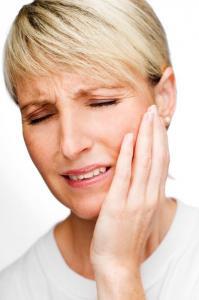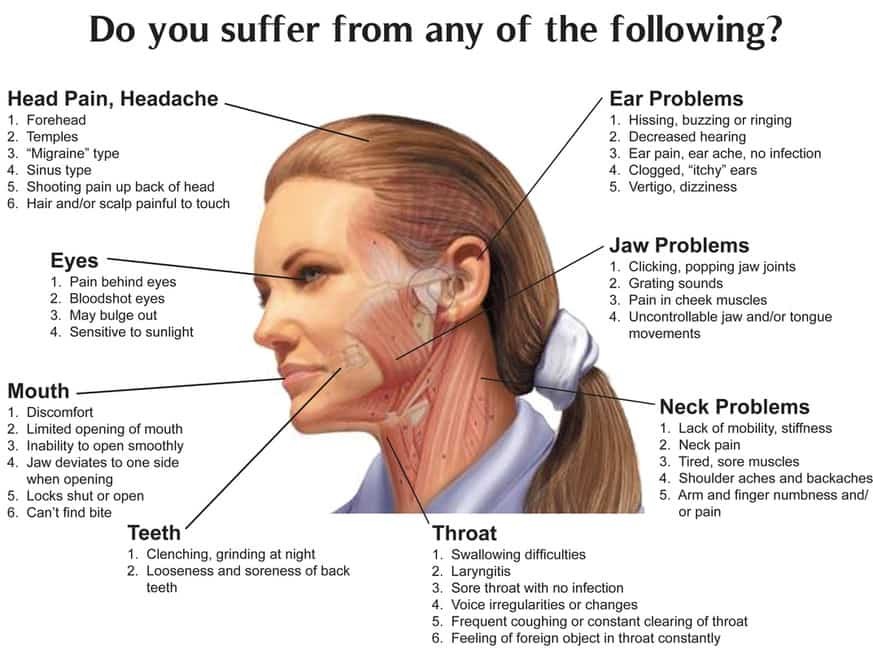TMJ Treatment
There are lots of simple home remedies for treating TMJ Pain: stretches, hot cloths, tongue exercises.
But if your jaw pain is bad enough that you’re considering a consultation with a dentist, we can possibly assume you’ve tried these remedies and need to consider a more serious approach.
The sources of TMJ Pain are facial muscles used for chewing, TMJ joint inflammation and teeth and gums getting too much pressure from Tooth Clenching. The cause of TMJ pain is the poor fit of the teeth top to bottom or what dentists call a bad bite. When teeth do not fit one another properly a patient needs to dislocate their TMJ joints to get their teeth to fit. The dislocation every time a patient chews, swallows, opens and closes causes muscles and TMJ joints to function in a poor position and causes neuromuscular pain and Tooth Clenching and Tooth Grinding and then more neuromuscular pain.
To solve or cure TMJ Pain it is necessary to correct a patients poor bite, so the patient will stop Tooth Clenching and Tooth Grinding. Some patients are not aware that they clench. Most of the time the Tooth Clenching happens at night.
Treating TMJ Pain at Natural Dentist Associates is done in two stages: 1) indirect treatment focusing mostly on reducing joint, muscle, gum and tooth inflammation. TMJ patients are treated by a TMJ Dentist with corrective bite Splint Therapy. Basically, records are taken to diagnose how the patients jaws and teeth are out of alignment. Subsequently, a corrective bite splint or Occlusal Splint is made to correct the misalignment. A splint looks a lot like a hard plastic mouth guard, but an Occlusal Splint actually has a corrective bite and cures the patients clenching problem. In severe cases Botox is used to medically calm down the muscles by injection of the drug into the tight chewing muscles. 2) once all the inflammation is better and the patient is asymptomatic, direct corrective treatment can be done to correct the patients bad bite. The correction depends on the patients problem. For example, a patients teeth may be in the wrong position and they may need to be orthodontically moved. The fit of the teeth may be poor and the patient may need bite adjustments and possibly some crowns and fillings redone. Occasionally, patients may have incompatible sized and shaped jaws top to bottom. In this latter case, surgery is the only true direct correction. Surgery is a serious decision and should not be taken lightly. Surgery should be the last resort and only performed when the symptoms are bad and there is a lot of dysfunction and all other options have been exhausted.
Increasingly, Botox is one treatment used by dentists and doctors in the treatment of acute severe TMJ Pain, Tooth Clenching and Tooth Grinding. It is important to note that Botox is an adjunctive treatment to actual corrective TMJ Therapy. Botox will have the effect of greatly reducing muscle tension, the patient feels less symptomatic and it is easier for the TMJ Dentist to diagnose and treat a TMJ patient. Botox will often lessen treatment time by shutting down muscle tension temporarily as the TMJ Dentist corrects the actual cause of TMJ Pain. From a biological standpoint, Botox impedes the body’s release of a neurotransmitter called acetylcholine in the areas where it is injected. Without the presence of this neurotransmitter, muscles in the area whereBotox is injected remain relaxed. Botox is more of a supportive therapy and not a corrective therapy.
Today, Botox is a household word best known, of course, for its aesthetic uses as a wrinkle relaxer, but it first caught on medically as a substance used to help people who had eye problems, particularly crossed eyes, or eye twitching.
A San Francisco-based ophthalmologist named Alan B. Scott realized in the 1960s that there could be medical uses for what we now call Botox. After testing the substance on cross-eyed monkeys for a decade or so, he received permission to test on humans in 1978.
Botox-using ophthalmologists noticed that the substance had one interesting side effect: Their patients were starting to look a little younger, because their wrinkles were disappearing after the treatment.
Since that time, Botox has also been used to treat everything from bladder spasms to excessive sweating. Lately, some Dentists have started stocking Botox as well. As it turns out, the same substance that can fix the problem of eye twitching can also be used, in many cases, to relax the jaw muscles that are at the root of TMJ pain.


